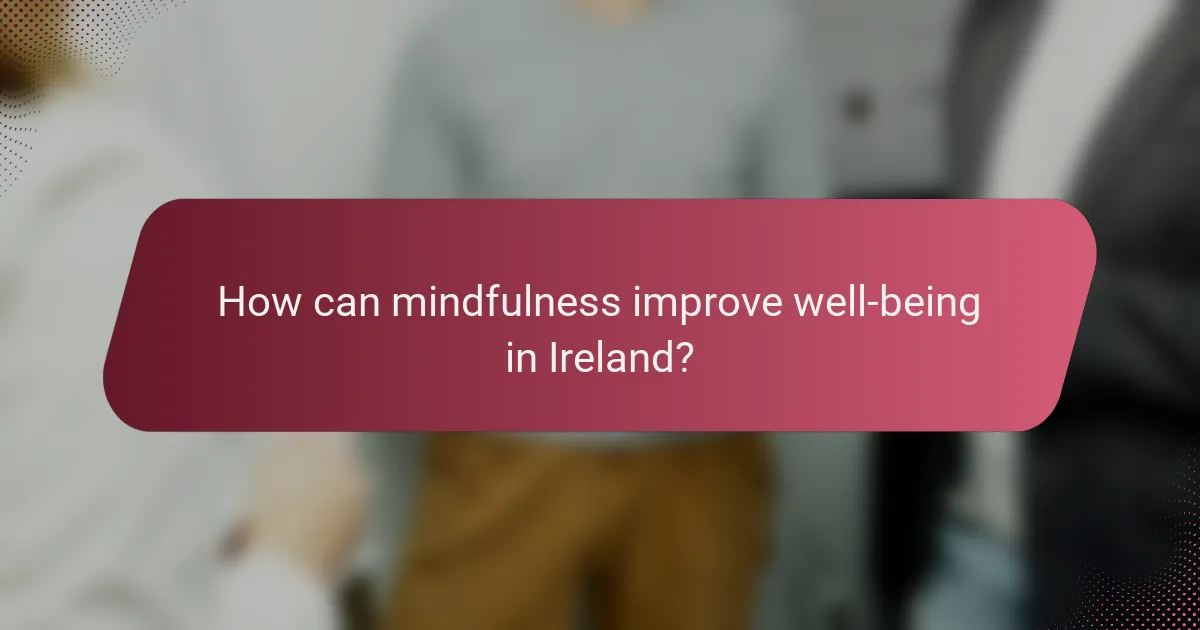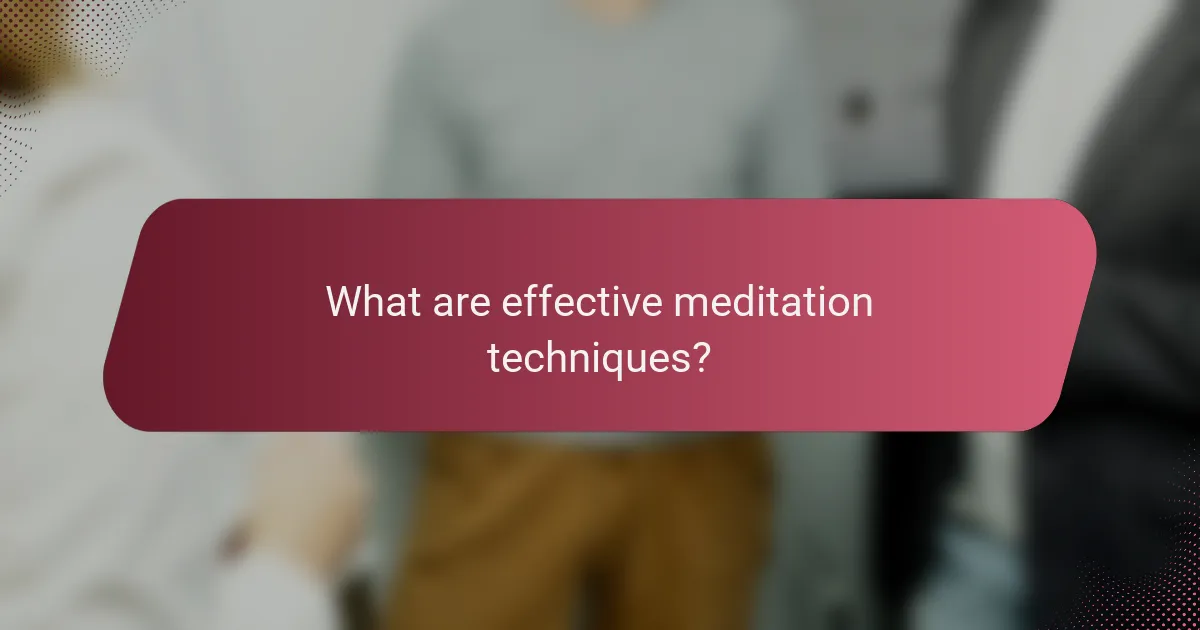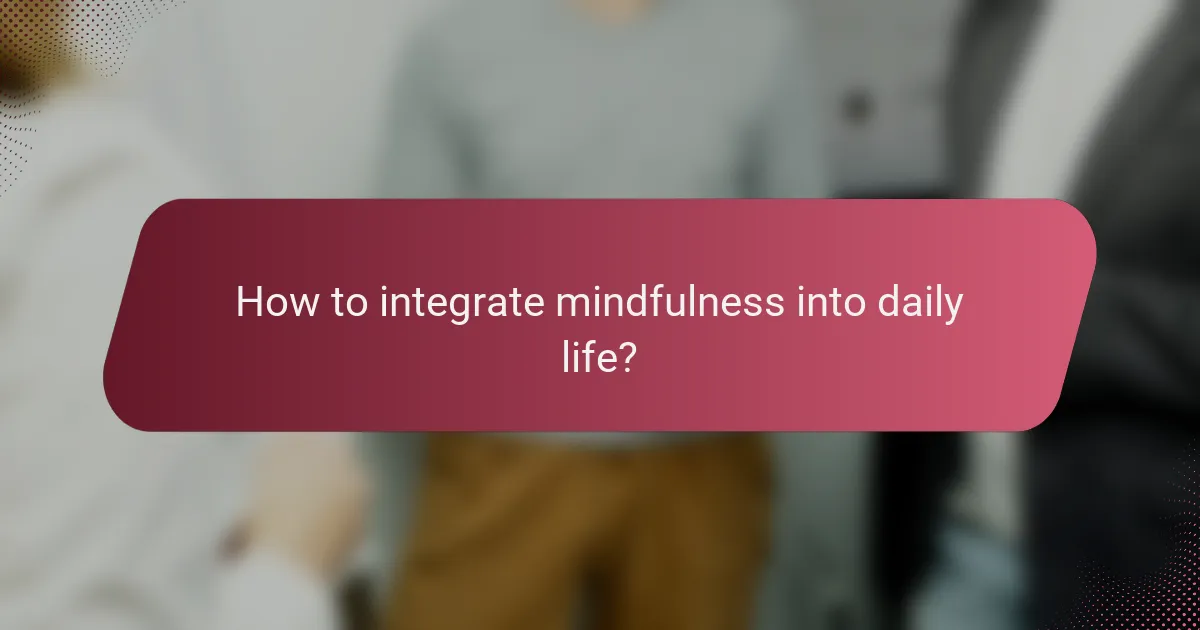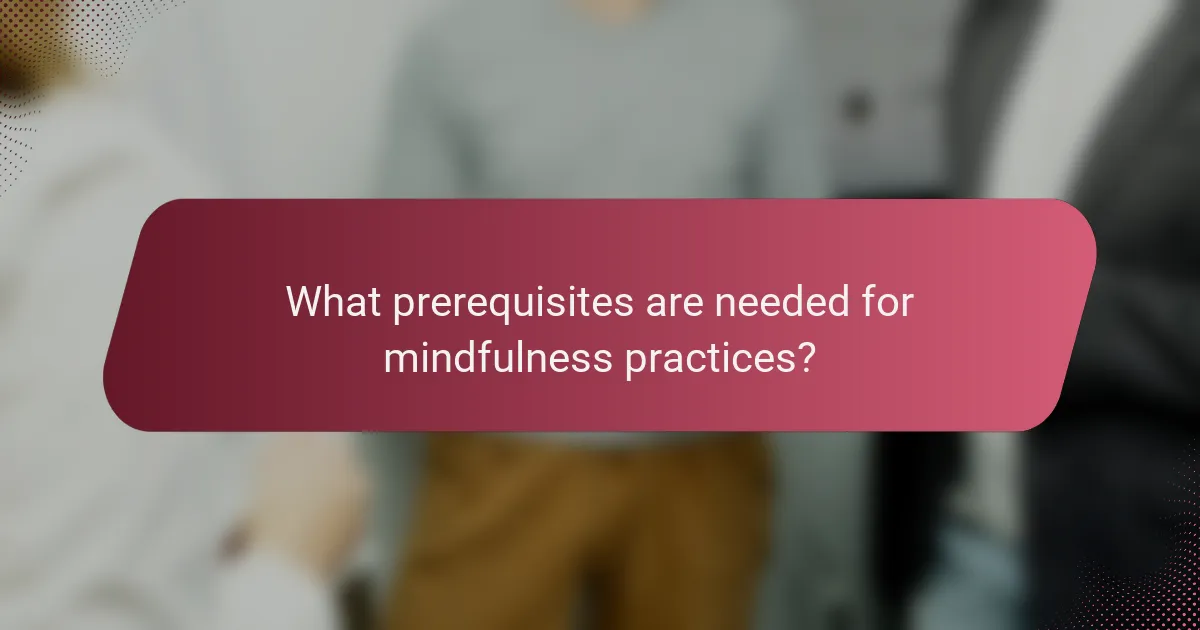Mindfulness and meditation are powerful practices that promote mental well-being by encouraging present-moment awareness and emotional regulation. By employing effective techniques, individuals can reduce stress and foster a positive outlook on life. Integrating mindfulness into daily routines allows for a seamless enhancement of awareness, making it accessible and beneficial for everyone.

How can mindfulness improve well-being in Ireland?
Mindfulness can significantly enhance well-being in Ireland by fostering a greater awareness of the present moment, which can lead to improved mental health and emotional resilience. Practicing mindfulness techniques helps individuals manage stress, regulate emotions, and cultivate a more positive outlook on life.
Reduces stress and anxiety
Mindfulness practices, such as meditation and deep breathing, can effectively reduce stress and anxiety levels. By focusing on the present moment, individuals can break the cycle of negative thoughts that often contribute to heightened anxiety. Regular practice can lead to a calmer mind and a more relaxed state throughout the day.
In Ireland, many people find that incorporating mindfulness into their daily routines helps them cope with the pressures of work and life. Simple techniques, like mindful walking or short meditation sessions, can be easily integrated into busy schedules.
Enhances emotional regulation
Mindfulness enhances emotional regulation by allowing individuals to observe their thoughts and feelings without immediate reaction. This awareness helps people respond to emotional triggers more thoughtfully rather than impulsively. Over time, this can lead to improved relationships and a greater sense of control over one’s emotional landscape.
Practicing mindfulness can be particularly beneficial in high-stress environments, such as workplaces in Ireland, where emotional responses can impact team dynamics and productivity. Techniques like journaling or guided meditations can support this process.
Improves focus and concentration
Mindfulness training can improve focus and concentration by training the brain to maintain attention on a single task. This practice reduces distractions and enhances cognitive performance, making it easier to complete tasks efficiently. Mindfulness exercises, such as body scans or focused breathing, can help sharpen attention spans.
In educational settings across Ireland, students who practice mindfulness often report better concentration during studies and exams. Simple techniques can be introduced in classrooms to help students stay engaged and attentive.
Promotes better sleep quality
Mindfulness can promote better sleep quality by calming the mind and reducing racing thoughts that interfere with falling asleep. Techniques such as guided sleep meditations or progressive muscle relaxation can help individuals unwind and prepare for restful sleep. Practicing mindfulness before bedtime can create a peaceful transition to sleep.
In Ireland, where busy lifestyles can disrupt sleep patterns, incorporating mindfulness into nighttime routines can be a practical solution for many. Establishing a consistent practice can lead to longer, more restorative sleep cycles.
Encourages a positive mindset
Mindfulness encourages a positive mindset by fostering gratitude and acceptance. Regularly practicing mindfulness can help individuals shift their focus from negative thoughts to positive experiences, enhancing overall life satisfaction. This shift can lead to improved mental health and resilience against challenges.
In the context of Irish culture, where community and connection are valued, mindfulness can strengthen social bonds. Engaging in group mindfulness activities, such as workshops or retreats, can further enhance feelings of positivity and support among participants.

What are effective meditation techniques?
Effective meditation techniques can help individuals cultivate mindfulness, reduce stress, and enhance overall well-being. These methods vary in approach and can be tailored to suit personal preferences and lifestyles.
Guided meditation
Guided meditation involves listening to a narrator or instructor who leads you through the meditation process. This technique is especially beneficial for beginners, as it provides direction and structure. You can find guided sessions through apps, online videos, or local classes.
When practicing guided meditation, choose a comfortable environment and set aside dedicated time to focus. Sessions can range from a few minutes to over an hour, depending on your availability and comfort level.
Mindfulness meditation
Mindfulness meditation emphasizes being present in the moment and observing thoughts and feelings without judgment. This technique often involves focusing on the breath or bodily sensations to anchor your awareness. It can be practiced anywhere, making it highly accessible.
To practice mindfulness meditation, start with short sessions of about 5 to 10 minutes and gradually increase the duration as you become more comfortable. Avoid distractions and create a quiet space to enhance your focus.
Transcendental meditation
Transcendental meditation (TM) is a specific form of meditation that involves silently repeating a mantra to settle the mind into a state of profound rest. TM is typically practiced for 15 to 20 minutes, twice a day, and is often taught through certified instructors.
This technique can lead to deep relaxation and reduced stress levels. However, it requires commitment and consistency to experience its full benefits. Consider finding a certified TM teacher for guidance.
Body scan meditation
Body scan meditation focuses on systematically bringing awareness to different parts of the body, promoting relaxation and tension release. This technique often starts at the toes and moves up to the head, encouraging a deep connection between the mind and body.
To practice body scan meditation, find a comfortable position and take your time with each body part. Aim for sessions lasting 10 to 30 minutes, and consider using guided recordings to help you stay on track.
Loving-kindness meditation
Loving-kindness meditation, or Metta, involves cultivating feelings of compassion and love towards oneself and others. This technique typically includes repeating phrases of goodwill and kindness, fostering a sense of connection and empathy.
Begin with short sessions of about 5 to 10 minutes, gradually expanding as you become more comfortable. Focus on specific individuals or groups, and allow the feelings of warmth and kindness to grow within you.

How to integrate mindfulness into daily life?
Integrating mindfulness into daily life involves incorporating simple practices that enhance awareness and presence in the moment. This can be achieved through various techniques that fit seamlessly into everyday routines.
Mindful breathing exercises
Mindful breathing exercises focus on the breath as a way to anchor your attention and cultivate awareness. Start by taking a few moments to breathe deeply, inhaling through the nose and exhaling through the mouth, paying attention to the sensations of each breath.
Try to practice these exercises for a few minutes each day. You can do this while sitting quietly or even during a short break at work. Noticing the rise and fall of your chest can help ground you in the present moment.
Incorporating mindfulness in routine activities
Mindfulness can be integrated into routine activities such as eating, walking, or washing dishes. When eating, for instance, focus on the flavors, textures, and aromas of your food, taking the time to chew slowly and savor each bite.
For walking, pay attention to the sensations in your feet and legs as you move. This practice not only enhances your experience but also helps reduce stress and increase overall satisfaction in daily tasks.
Setting aside time for meditation
Setting aside dedicated time for meditation is crucial for deepening your mindfulness practice. Aim for at least 10-20 minutes daily, ideally at the same time each day to establish a routine.
Find a quiet space where you won’t be disturbed. You can sit comfortably or lie down, closing your eyes and focusing on your breath or a specific mantra. Consistency is key to experiencing the benefits of meditation.
Using mindfulness apps like Headspace
Mindfulness apps such as Headspace can provide guided meditations and mindfulness exercises to help you stay on track. These apps often offer a variety of sessions tailored to different needs, such as stress reduction, sleep improvement, or focus enhancement.
Many of these apps include reminders and progress tracking features, making it easier to integrate mindfulness into your daily routine. Consider exploring free trials to find the app that best suits your preferences and lifestyle.

What are the benefits of mindfulness in the workplace?
Mindfulness in the workplace offers numerous benefits, including improved focus, enhanced collaboration, and reduced stress levels. By integrating mindfulness practices, organizations can foster a healthier work environment that boosts overall employee well-being and productivity.
Increases productivity
Mindfulness techniques, such as meditation and focused breathing, can significantly enhance productivity by improving concentration and reducing distractions. Employees who practice mindfulness often report being able to complete tasks more efficiently, as they can maintain focus for longer periods.
To implement mindfulness for productivity, consider scheduling short breaks for meditation or breathing exercises during the workday. Even a few minutes can help reset attention and increase output.
Enhances team collaboration
Mindfulness promotes better communication and empathy among team members, which enhances collaboration. When employees are present and attentive, they are more likely to listen actively and respond thoughtfully, leading to more effective teamwork.
Encouraging group mindfulness activities, such as team meditation sessions, can strengthen relationships and foster a supportive work culture. This can lead to more innovative solutions and a more cohesive team dynamic.
Reduces workplace stress
Practicing mindfulness can help reduce workplace stress by providing employees with tools to manage anxiety and pressure. Techniques such as mindfulness meditation can lower cortisol levels, which are often elevated in stressful environments.
Employers can support stress reduction by offering mindfulness workshops or resources that teach employees how to incorporate mindfulness into their daily routines. This proactive approach can lead to a healthier workplace atmosphere.
Improves employee satisfaction
Mindfulness contributes to higher employee satisfaction by promoting a sense of well-being and work-life balance. When employees feel less stressed and more engaged, they are generally more satisfied with their jobs.
To enhance satisfaction, organizations can create a culture that values mindfulness by providing flexible work hours or quiet spaces for meditation. Such initiatives can lead to lower turnover rates and a more committed workforce.

What prerequisites are needed for mindfulness practices?
To effectively engage in mindfulness practices, individuals should possess a willingness to participate and an openness to experience. These prerequisites help create a conducive environment for learning and applying mindfulness techniques.
Willingness to engage
Willingness to engage is crucial for successful mindfulness practices. It involves a readiness to explore one’s thoughts and feelings without judgment, allowing for deeper self-awareness and understanding. This mindset can significantly enhance the benefits of mindfulness, making it easier to integrate into daily life.
To cultivate this willingness, start by setting aside time each day for mindfulness exercises, even if it’s just a few minutes. Gradually increase the duration as comfort grows. Engaging in guided meditations or mindfulness apps can also provide structure and encouragement.
Avoid common pitfalls such as self-criticism or impatience. Mindfulness is a skill that develops over time, so approach it with an open heart and a sense of curiosity. Remember, the journey is as important as the outcome.
